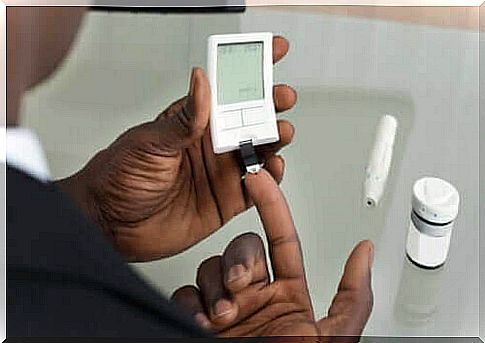Diabetes Increases The Risk Of Bone Fractures

Diabetes increases the risk of bone fractures. Among all the complications that diabetes causes, it is one of the biggest. Diabetes is a metabolic disease, but it does not only affect the presence of substances in the blood. In this disease, blood sugar increases along with the likelihood of suffering from other disorders.
There are several reasons why the increased circulation of sugar in the blood affects bone tissue. Still, it is possible to make some reservations. Read here to learn more.
Metabolism in patients with diabetes
As we have mentioned before, diabetes is a metabolic disease. The primary sign of its occurrence is the increased concentration of sugar in the blood. This is usually remarkable on an empty stomach before eating any kind of food.
As a metabolic disease, diabetes not only affects blood sugar, but it also changes balances of lipids, protein and minerals. Insulin, which is the altered hormone in this case, affects many processes in the body.
The well-known complications of this disease have to do with the heart and kidneys. However, we also need to add the effect it has on bone tissue. Bones are dependent on both calcium levels and the ability of bone tissue to produce it.
Reasons why diabetes increases the risk of bone fractures
Both men and women with diabetes have a higher risk of bone fractures. Hormonal changes, inflammation and even some drugs affect this complication. What other possible triggers are there?
Neuropathy
Prolonged high blood sugar damages the fat layer on the outside of neurons. Nerves, especially those in the lower limbs, transmit nerve impulses in a less efficient manner. Overall, diabetic neuropathy shifts the balance, so people with this disease tend to fall more.
Dysautonomy
This term refers to poor functioning of the nervous system, especially in the autonomic. It is the part of the nerves that regulates and controls all the functions that do not need a direct or conscious command.
That way, when it comes to diabetic dysautonomy, patients have trouble maintaining blood pressure when they get up. As a result, they tend to faint and feel dizzy, which often leads to them falling and suffering from bone fractures.
Osteoporosis
Osteoporosis is more common among diabetics than the rest of the population. Insulin is an anabolic hormone that stimulates the formation of tissue. Since they do not produce it as they should, the process of repairing bones becomes slower.
Retinopathy
Retinopathy is another major complication of diabetes. The small arteries that sit in the retina burst without the ability to clot, and this affects vision as a consequence. Of course, any disturbance of vision increases the likelihood of falling and breaking something.
Which bone fractures are the most common in patients with diabetes?
Several studies conducted with patients with diabetes have been able to establish the relative frequency at which they experience bone fractures. This is excellent because they serve as a guide to which parts of the body frequently vomit in these patients.
First, there is type 1 diabetes. In this case, there is not enough insulin in the person’s body, so they need to get more out of it and artificially. People with type 1 diabetes tend to suffer from osteoporosis as well as vision problems.
Hypoglycemia also plays a role in this case, as many patients tend to mix the appropriate dosages at any time during the day together. As you probably know by now, low sugar levels cause dizziness, which can lead to accidents.
With this type of diabetes, the most common bone fractures are those of the hip and spine. This was particularly noticeable in people with comorbidities with kidney or heart disease.
On the other hand , the most common bone fractures in type 2 diabetes are those in the forearm and hip. Although the bone density of these patients is not much different from that of the rest of the population, professionals suspect that sugar affects the bone mechanisms.

This is how you can prevent accidents, even if diabetes increases the risk of bone fractures
Although statistics indicate that diabetes increases the risk of bone fractures, there are things that can be done (in addition to glycemic control) to prevent that damage.
As mentioned earlier, the most important thing here is to talk to a specialist to follow up on it constantly. The patient should follow a strict diet and take medication to keep his sugar levels within the normal value so that heart and kidney problems do not appear.
In addition, physical activity is extremely important here. In the event that you did not know that diabetes increases the risk of bone fractures, then it is actually much worse in individuals who are sedentary or have less muscle mass. During exercise, sugar helps to penetrate the muscles and it strengthens bone tissue.
Incorporating vitamin D into the diet is something that we will also need to mention. Most people like to do this by exposing themselves to the sun on a regular basis.
However, this can be artificially supplemented with drugs that are prescribed when the person’s values are very low or if they live in cold areas where there is not much sunlight during the year.
Green leafy vegetables are a good solution for incorporating vitamins and calcium, which can also be obtained from dairy products. A regular supply of these foods helps bones recover and maintains their internal density. As a result, the likelihood of bone fractures decreases.

Bone density measurements are important when diabetes increases the risk of bone fractures
In addition to taking preventative measures , patients with diabetes should also have bone density measurements taken. This study measures the concentration of bone and allows the patient to know if the risk of bone fracture is higher due to weak tissue.
All patients can take control of the disease and follow measures to take care of themselves. However, it is fundamental to keep in mind the importance of following it up with a professional and taking the necessary precautions to reduce the risk of bone damage.









